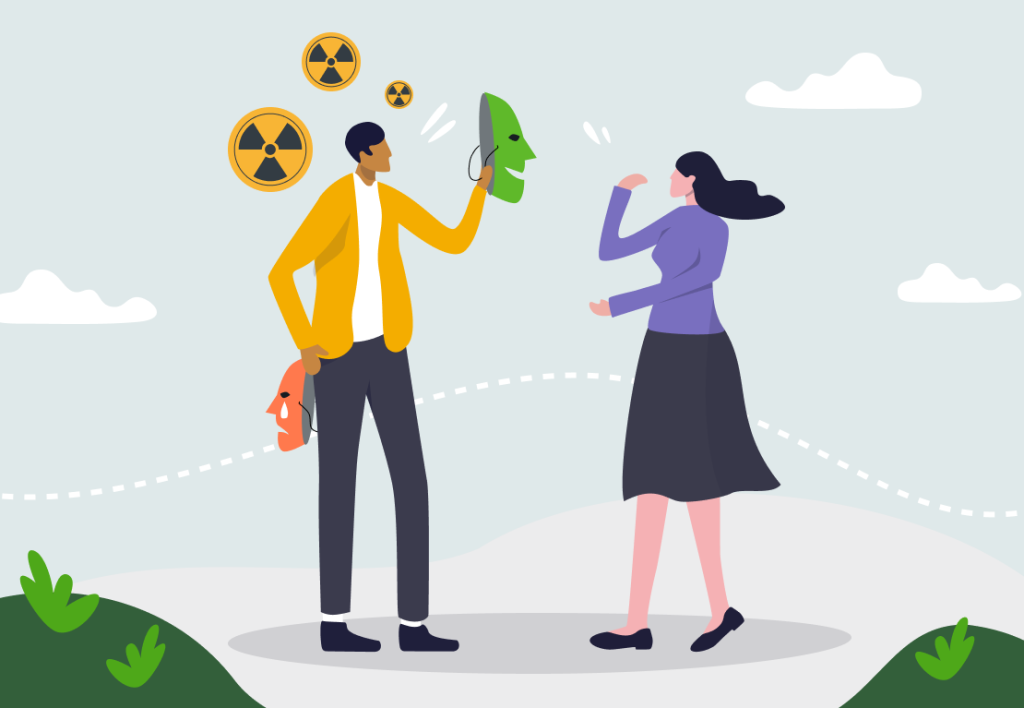How toxic positivity in the workplace hurts our sanity

We shouldn’t tolerate toxic workplaces, but we shouldn’t be okay with toxic positivity in the workplace, either. Confusing? I’ll explain.
I don’t know about you, but I think I’m a little allergic to people who *stay positive* at all times. It could be because I’m Latvian, and we have a natural inborn grumpiness. But it’s not just me, and there is such a thing as toxic positivity.
How can positivity be toxic in the first place? What does toxic positivity look like in the workplace, and what to do about it? Keep reading, and arm yourself with answers.
Want to get the most out of your time?
Try DeskTime for free!
Try free for 14 days · No credit card required.
By signing up, you agree to our terms and privacy policy.

What is toxic positivity?
Toxic positivity is a belief that no matter how problematic and painful a situation is, one must maintain a positive mindset. While this may sound like having a positive mental attitude – approaching unpleasant situations in a hopeful and productive way – toxic positivity completely rejects difficult emotions to maintain a cheerful appearance.
You may ask – how can a cheerful appearance harm me?
It’s not the positivity that’s the problem, but rather the fakeness of it. By denying burdensome emotions as part of the toxic positivity, you don’t make them magically disappear.
Unprocessed feelings and blocked emotions can cause many health issues, such as mental illnesses, cardiovascular diseases, insomnia, headaches, and more. Also, by neglecting complicated feelings, people prohibit themselves from much-needed support and an option to process situations healthily.
And what’s quite fascinating is that bottled-up negativity finds its way back into our lives. It can appear as feeling guilty or ashamed about having emotions at all, avoiding situations that might make us feel uncomfortable, and neglecting our chances for personal growth.
What is toxic positivity in the workplace?

Same as in the personal context, toxic positivity in the workplace can often go unnoticed due to being mistaken for a positive mindset incorporated into the company culture. It can also be a result of having several members of a team bringing toxic positivity into the workplace, which then infiltrates the company culture.
How can you spot toxic positivity at work?
There’s no foolproof way, but here are several examples of how toxic positivity can manifest in the workplace:
- Use of overly friendly language, for example, an employer constantly emphasizing that you’re all one big family.
- Pointing fingers at how other workplaces and companies have it worse, even when yours is in crisis.
- “Everything’s fine” and “no worries” vibes in situations when it’s all hectic.
- Not addressing employee complaints and sweeping them under the rug – “I don’t see a problem here”.
- Employees do not speak up or share their struggles with coworkers or management, ever.
Of course, this list of examples isn’t exhaustive, but I hope you got the idea.
Why is toxic positivity bad for the workplace?

Regardless of how the “good vibes only” sentiment has gotten into the organization, there are several reasons why toxic positivity hurts everyone involved.
- Issues stay ignored. Most company-wide issues or problems in the workplace require active problem-solving rather than just wishful thinking. Thus, with toxic positivity in place, serious issues can be left unresolved and have dire consequences.
- The workplace feels insincere. Toxic positivity diminishes the importance of trust and honesty. If no one addresses your concerns, what’s the point of voicing them? As a result, the workplace lacks sincerity and openness.
- Employees feel isolated. Toxic positivity can make employees feel like something’s wrong with them as they’re seemingly the only ones having difficulties at work. It creates a sense of deep isolation, harming employee well-being.
- Higher burnout risk. Toxic positivity in the workplace can also be used to mask unreasonable workloads. This is especially noticeable in the “one big family” mentality, which motivates employees to put in longer hours or greater effort to deal with irrationally large work amounts. Plus, bottled-up issues and emotions negatively affect employee mental health, contributing to higher risks of burnout.
- Limited chances for creative tension. Facing our emotions and acknowledging dissatisfaction can put people in creation mode – “I don’t like this, and I can provide a better solution”. Whereas toxic positivity dismisses negative feedback, limiting opportunities for creative tension – a productive state where ideas can be freely expressed, criticized, and reinvented. A healthy dose of creative tension motivates teams to work together to create and showcase their best work.
Generally speaking, toxic positivity at work puts massive pressure on everyone involved to stay in unhealthy and dysfunctional systems in exchange for employee sanity and well-being. Not to mention the harm such an approach can do to a company if business-related issues are swept under the rug rather than rationally solved.
Tackling toxic positivity at work as a manager

Being a manager, it’s your direct responsibility to ensure your company has a healthy culture, thus, there’s no room for toxic positivity at work. To ease your task, here are three ways to start tackling your organization’s “good vibes only” sentiment.
1. Make room for complaints and struggle-sharing
It’s crucial that your employees know they CAN share whatever bothers them. In an environment where sharing struggles has never been on the agenda, this approach will take time to sink in.
You can offer employees an option to submit their thoughts and feedback without engaging in an eye-to-eye conversation, as that can be uncomfortable for some. People often feel more at ease sharing their struggles in a written format. Making it possible to do so anonymously is another way to open the gates.
Don’t overlook an HR specialist’s or organizational psychologist’s involvement – they’re trained to deal with such situations. Plus, if they’re someone “from the outside”, your employees may feel more comfortable talking to them.
2. Lead by example
Cultivating open communication among your workers starts with yourself. Thus, it’s essential to be transparent and honest about your own thoughts and decisions to encourage your team to do the same.
Contrary to ancient beliefs, it’s good to show your employees that their employer is also just a human with emotions. You can share what you’ve been struggling with during a team meeting without asking your employees to do the same. Take it slow to build an environment of trust, and after some time, you can begin inviting workers to share their problems if they’re up for it.
3. Prioritize employee well-being
Neglected by toxic positivity, employee well-being could be suffering in your organization. Hence, making it a priority is the way to go when trying to eliminate obsession with positive thinking in the workplace.
You can begin by surveying your workers on their well-being levels – ideally, using an anonymous survey. The results will help you identify the most significant pain points and act accordingly.
One thing that can never be underestimated is encouraging healthy work-life balance in the workplace. Promote taking regular breaks at work and pay attention to those working overtime. They could be dealing with more work than they can handle.

Want to prevent overworking?
Prioritize and set healthy boundaries!
Additionally, provide wellness programs that promote physical and mental health, such as on-site yoga classes, paid therapy, or mindfulness training. Adding mental health days to your company policy can also powerfully deliver a message that it’s ok not to be ok.
Fighting toxic positivity as an employee

If you’re an employee working in a toxic positivity workplace, it doesn’t have to be a lost cause. Here’s what you can do:
- Speak up and share. Have you been struggling with motivation lately? Is there too much work on your plate? Instead of beating yourself up for not being able to hustle and smile, go to your manager or HR representative and share your struggles. Staying silent and trying to push through tough times won’t solve the more significant issue residing in your workplace.
- Call out the toxic positivity. If you’re spotting traits of toxic positivity, voice it nonaggressively. Do your best to explain why it would be better to acknowledge the issue or someone’s feelings rather than simply suggesting to find a silver lining.
- Show empathy towards others. Not all people are naturally empathetic, and prolonged periods of stress can make us less tolerant of others and their feelings. But cultivating compassion is crucial in getting rid of toxic positivity at work. Start by checking in with your closest workmates. Be observant and notice if people around you act differently than usual. But don’t interrogate them – a simple “I’m here if you ever want to talk” is a much better way to approach such situations.
- Find compassion toward yourself. I know it’s easier said than done. Many of us are harsh when it comes to our struggles. While the best way to display more compassion towards yourself would be to have a therapist help you, you can also implement small things into your daily routine. For example, if you made a mistake, tell yourself that it’s ok and everybody makes mistakes. Even if it’s just a phrase at the beginning, it’s one way to begin walking the self-compassion road.
Feeling all the feels? Congratulations, you’re a human being!
According to data, we’ll spend about one-third of our lives at work. What’s the point of spending one-third of our existence pretending to be all sunshine when we’re really feeling all changing weather?
It’s okay to feel sad, angry, or anxious at times. Emotions are not inherently good or bad – they are simply a natural response to our experiences and surroundings.
As for the workplace, creating a culture where employees feel comfortable sharing their emotions without fear of judgment can lead to a more productive and positive work environment. By acknowledging and supporting each other, we can foster a sense of empathy, understanding, and connection in the workplace.
Did you find this article useful? Give it a clap!
Psst! You can clap more than once if you really loved it 🙂